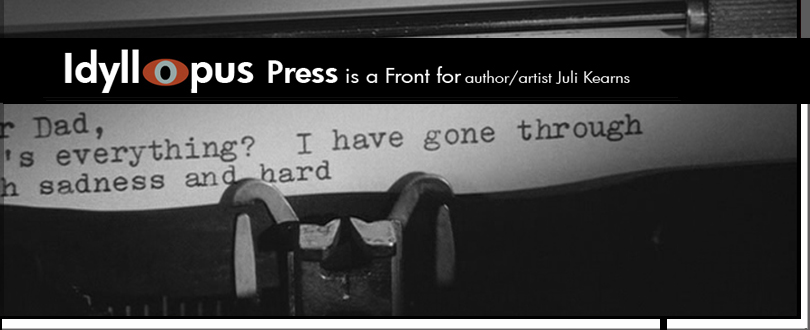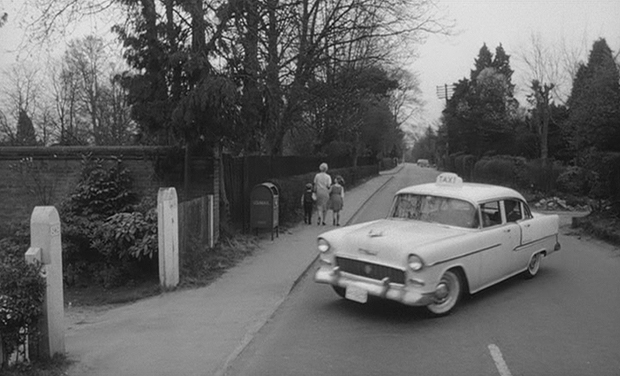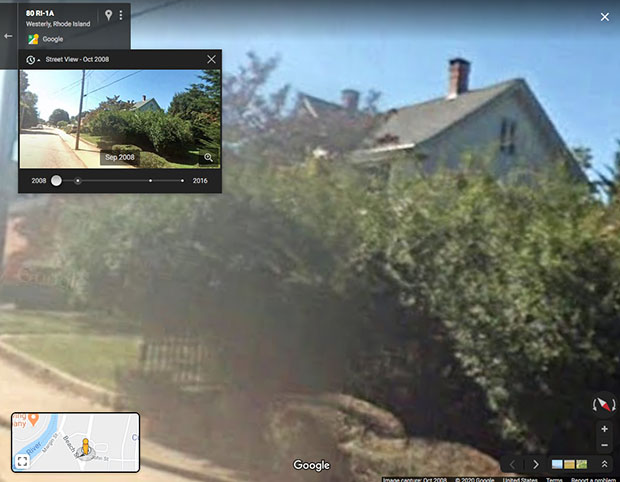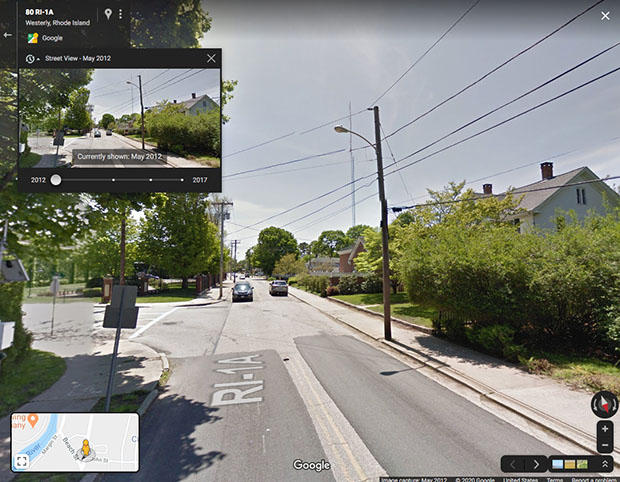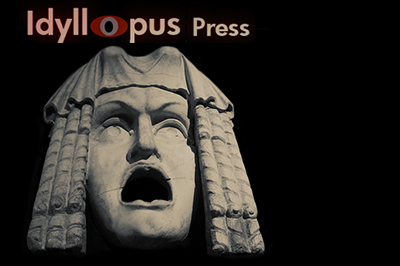The Location of Humbert's Taxi Drive Transition from Westerly, RI to Charlotte's Ramsdale House, in Kubrick's Lolita
An Examination of the Transition
Go to TOC for this film ( (which has also a statement on purpose and manner of analysis and a disclaimer as to caveat emptor and my knowing anything authoritatively, which I do not, but I do try to not know earnestly, with some discretion, and considerable thought).
Humbert arriving in Ramsdale, New Hampshire, is depicted as traveling away from the train station, in a taxi, in shot 69, a crossfade then taking the cab to a tree-lined residential street in shot 70, the cab moving away from the camera, then a crossfade to shot 71 has the cab traveling towards us and taking a screen left turn into the drive of Charlotte's 242 home.
We already know that shot 69 takes place in Westerly, Rhode Island, the cab traveling down Railroad Avenue and turning onto Canal Street.
And we know that Charlotte's home, in shot 71, is on Packhorse Road in Chalfont in England.
Back when I was exploring some of these locations, via Google Maps I traveled all over Westerly looking for where the cab may have been in shot 70, and had examined Elm Street many times but with no success. It looked right, but I couldn't find the intersection where the transition occurs. What I most focused on finding was, as seen in the below screengrab, the house on screen left, at the corner of a side street, and what may have been the side of a store or possibly a church, but didn't seem a residence, just across another side street on screen right. Unable to find this, knowing already that Elm disease would have changed the flora quite a bit, I wondered if somehow this residential area had been so changed as to be unrecognizable. Usually, with a very settled, older residential area in a town, though there may be changes, such dramatic ones are unlikely to occur. I also checked out Newport, Rhode Island, but had no luck there. Elm Street in Westerly seemed a good bet but I couldn't make a fit.
Recently @nycsightssounds (on Instagram), wrote me to say they knew the area well, having grown up in there, believed it was likely on Elm Street, and that they had discussed it with others who also felt it was on Elm Street. They were returning to the area for a visit and said they would take a drive down Elm, filming it, and see if they had any luck. They subsequently sent the films, as well as this below photo of a house on Elm Street that had stood out to them as looking like it might be a good fit for a house seen briefly on screen right in the film just before the left side street is passed.
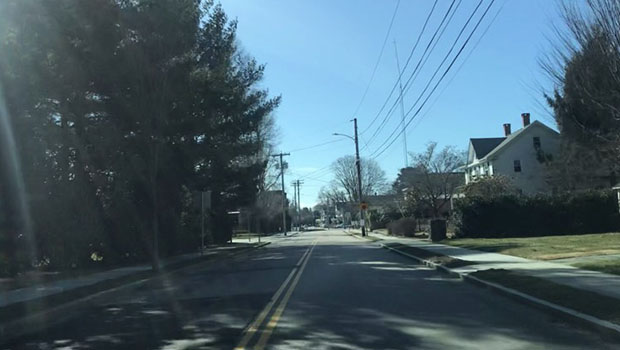
The photo of the house on Elm Street, 2020
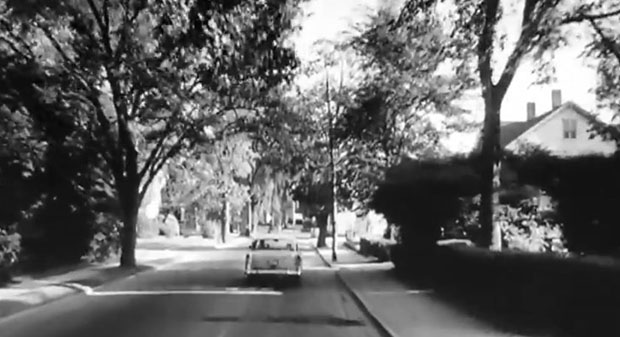
The house in the film in shot 70
At first glance, I thought it had to be it. The two chimneys and the gable between. The lone second floor window. The width of the walks. But I know too well how appearances can be sometimes deceiving, and looking at it again I wondered about the differences. Not only was the area markedly different, the sidewalk on the right was fully paved to the street in the film. Also the sash of the second floor window in the 2020 house looked a little different in close-up, but that could have been changed.
Things seemed so changed, I was doubtful. But I kept looking at that sidewalk on the left, how it fit so well, and the relationship of the house to the left side street was perfect. So, I went to look up the location on Google Maps, using the oldest images available, from 2008 and 2012. The address on these gives 80 RI-1A but the house number is actually 81, on Elm, alternatively Highway 1A.
I think this is undeniably the same house as in the film, that @nycsightssounds has located it. The sash in the upper story is the same as in the film, but that's a minor thing. The screen right sidewalk is still paved all the way to the street in 2008 and 2012. We see that the relationship of the lawn to the sidewalk is as in the film. The left side street seems to be in correct relationship to the house's yard as in the film, and the curve on that left sidewalk at the side street is as in the film. I think we can even glimpse, in the flim, the manhole cover in the curve of the left sidewalk that is clearly shown on Google maps. The telephone pole on the left seems to be in approximately the same place. The telephone pole on the right? I don't know, the shadow throws me. Spatial distortion in Google Maps, depending on where one is situated, affects the pole's relationship to the opposite side street. From some perspectives it appears it may have been moved, but from others it doesn't.
Some of the dramatic changes are that the residence house across the way has been taken up by Darlington Fabrics, and that there is also now a house squeezed in just beyond 81 Elm Street, on the corner of Elm and Beach. For I was wrong in assuming I was looking for a right side street that met the main one perpendicularly. Though this appeared the case in the film, actually this is where Elm meets Beach Street, the two streets having run parallel to each other up to this point, then converging in a kind of quadrangle. The house now just beyond 81 Elm is 22 Beach Street. Google Maps also gives 24 as being there, and I don't know if there used to be a 24 Beach Street but perhaps there used to be.
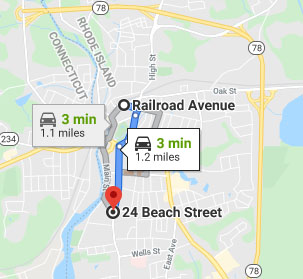
Relationship of 81 Elm Street and neighboring 22/24 Beach to Railroad Ave. Click for close-up.
Above we see the relationship of 81 Elm Street to Railroad Avenue. We also see that we're right on the border of Rhode Island and Connecticut.
@nycsightssounds asked me why might Kubrick have chosen to film in Westerly?
My immediate response would have been Kubrick likes liminal/boundary areas, places where opposites meet. For instance, Humbert is supposed to take Lolita to a hotel in the White Mountains (in the book), but though they are supposed to be in the east, and we do see a Newport, Rhode Island Ferry, and a toll bridge between Kittery, Maine and Portsmouth, New Hampshire when Humbert is driving to pick up Lolita at the camp, the scene in which Humbert drives Lolita to the hotel takes place in the Black Hills of South Dakota as far as the front screen projection is concerned, footage which was shot for the film and wasn't stock. In The Shining, though The Overlook is in Colorado, the two drives up to it position the hotel on the Colorado Divide, the first drive approaching it from the east and the second drive up approaching it from the west.
I would have supposed perhaps Kubrick liked the idea of the liminal boundary of the west/east with Westerly. But I'd also like to propose something else, due Westerly, Rhode Island immediately bordering Connecticut.
Robert Myron Coates, born in New Haven, Connecticut, was an art critic for New Yorker, as well as a writer, his writings sometimes appearing in the same issues as work by Nabokov, such as in the May 15, 1943 issue where we have Coates "Wrong Cavity", and Nabokov's poem "On Discovering a Butterly", and the February 11, 1950 issue where we have Nabokov's story "Lantern Slides", and Coates writing on art.
November 1, 1947, the New Yorker published Coates "The Hour After Westerly", later published in a book of short stories, under that title, in 1957. The story concerns a salesman who is traveling home, from Providence, Rhode Island, to New Haven, Connecticut, a 100 to 110 mile trip that should take about about three hours, and is a journey he makes about twice a month. He starts out at 4:18, having phoned his wife to tell her he will be home for dinner at 7:30. He travels down to the junction of Route 3 and the Boston Post Road, and then the next thing he's aware he's between New London and Saybrook, at the sign "Niantic 2 M", it is 7:30, and he still has an hour's drive remaining. At first he's not surprised, though a little confused. He stops to have dinner at a restaurant, and when he sees the time is "eight-six", "on the instant a whole series of questions that had existed before only as a dull disturbance in his consciousness came immediately into focus." He tries to examine what had happened, where he had been, and he does remember certain scenes distinctly, such as a gas station, picnickers in a hay wagon, a yellow roadster, but he knows there are places he should have passed through that he doesn't recollect at all. "It was as if he had been driving in a fog, and the one thing he did remember was an image as precise and as unrelated as something one might see through a sudden parting of a fog--a group of small white houses grouped at an intersection, and a clock (was it on a steeple?) with the clock's hands pointing to ten minutes to six..."
He decides he's just been working too hard, but he can't put what happened aside and later attempts to retrace his trip. He locates the place where he'd seen the roadster, and the picnickers, then finds himself approaching...
...with trepidation, the invisible point where his memory ended and the unknown began.
He found he couldn't locate the dividing line exactly. To remember is one thing, but to define what you don't remember is another, and that, in a way, was what David was trying to do. About all he could tell was that somewhere around the state line between Rhode Island and Connecticut a sort of assurance left him; he knew the road from then on, of course, and he followed it, but it seemed, in an odd way, strange to him, and when he reached the Niantic crossroad ("Niantic 2 M", the sign still siad) and found himself again on ground that was completely familiar, a sort of sadness overcame him, as if he had lost something that now might never be regained.
On another trip, he finds the grouping of white houses he had decided must be a dream. There were two ways of going from Providence to New Haven, one following the shore, and a shorter more direct route that he always takes. This time, he cuts down to the shore line road as he sells hardware and he's heard a new hardware store has opened in Westerly. The road is unfamiliar to him...
...Yet, it had, in an odd way, a feeling of familiarity, too. It was like something that he had seen once and had half forgotten but that recalled itself to him, landmark by landmark, as he went along; it was, in that sense, just the opposite of his previous experience, when he had forgotten what he had gone through, and although he had decided to put that out of his mind--and by this time had almost succeeded in doing so...he could not help a feeling of rising excitement as he drove into the town of Westerly.
Once again, though, it wasn't the town. There were houses that were white (after all, almost all New England houses are white), and they were grouped around an intersection. But they weren't the right houses, in the right arrangement, and the hardware store, too, turned out to be a disappointment.
He asks directions for leaving town for New London, and follows them but becomes lost in the outskirts of town, which is when he runs into the grouping of white houses with a picket fence and elm tree and the steeple and the clock, which now reads 5:35. He follows the road and feels a sense of exciting freedom, retracing his way down a path he feels he's previously taken, but no remembrances return. He passes a cottage where there is an attractive woman in the yard, and though he's certain he hasn't seen her before, he feels he should stop, he feels she recognized him as he passed, he feels the car itself wanting to pull over, but he drives on.
Having not stopped, his sense of adventure leaves him. He goes to a bar to ask directions, and inside he notes the beer sign "in the window, and visible in reverse from the inside". The bartender acts like he recognizes him, then when he serves him a beer the bartender asks to make sure, uncertain now. Has he been there before? Davis says he hasn't. The bartender seems now convinced that Davis had been there before and suspicious of him. Disturbed, Davis leaves.
He returns one more time to the area, six weeks later, in the autumn. He doesn't see the woman. The steeple clock had read "eight minutes to six". He walks around in the woman's yard then goes home. He passes the bar where "Narragansett Beer" is sold, which he had seen in reverse before, from inside the bar. And, if you notice, this last visit is at "eight minutes to six", whereas when he stopped to eat after realizing something was odd during his initial journey, it was at eight-six, and it had been with his seeing the time was eight-six that "on the instant a whole series of questions that had existed before only as a dull disturbance in his consciousness came immediately into focus."
We have a liminal area at Westerly, on the boundary of Rhode Island and Connecticut, that Coates embraces with the number "eight-six" and "eight minutes to six", the time of "eight-six" being when the character had fully comprehended something had happened, as if waking up, questions about it coming then into focus, then on the far side of his journey the time is "eight minutes to six", a reversal, and he sees the beer sign iin its proper orientation.
Kubrick likes reversals and liminal areas. He likes to use doubles and mirrorings. He just does. 24/42 are numbers he uses frequently, which are forged together to form 242 where Charlotte lives (not Nabokov's original number), and is the room number where he stays with Lolita at the Enchanted Hunters hotel. These reversals/mirrorings are even addressed in the film, via Edgar Allan Poe's poem "Ulalume", which Humbert reads to Lolita.
It was hard by the dim lake of Auber
In the misty mid region of Weir...
Humbert points out to Lolita, "You see, he takes a word like 'dim' in one line and twists it? You see? And it comes back as 'mid region of Weir'."
The poem concerns Psyche's attempt to prevent a man from following a path he will eventually realize returns him to the tomb of his lost Ulalume. It was on that very night in October, a year past, that he had previously made the journey, "that I brought a dread burden down here".
The story of Lolita, if we consider its barest outline, purging it of Humbert's abuses and all other content, is one that is, in the book, the reanimation of a lost love of Humbert's youth, who Nabokov intended to look like Lolita. In this scene in which the poem, Ulalume, is read, Nabokov's screenplay had Humbert show Lolita a picture of the girl he'd once known, taken at "a princedom by the sea", and it was supposed to be a picture of Sue Lyon, who played Lolita, but Lolita would fail to see how they looked alike. Wisely, Kubrick eliminated this.
This kind of déjà vu isn't novel to Kubrick's Lolita. The Shining is all déjà vu, Jack feeling he knows the hotel, and the past attempting to assert itself in the present. In A Clockwork Orange, Alex experiences the same déjà vu with his accidental revisiting of HOME, where the writer recognizes him as one of the thugs who'd beaten him up and raped his wife.
Westerly is also where Humbert arrives (in fictional Ramsdale) via railroad, and Kubrick in other films has associated the uncanny, deja-vu like repetition of events with railroad imagery. We find his doing so in A Clockwork Orange, The Shining, and Eyes Wide Shut.
It may very well be that the story "The Hour After Westerly" has nothing to do with Kubrick's choice of Westerly for where we make the transition to Lolita and Charlotte's home, address 242, the crossfade occurring between 81 Elm Street and about the point of 24 Beach. But I would be surprised if Kubrick wasn't familiar with the story and if it hadn't influenced his choice of location for the destination of Humbert's train trip, and his drive into the unexpected world of Lolita.
Thanks again to @nycsightssounds for finding the location for shot 70!
March 2020. Approx 2680 words or 6 single-spaced pages. A 20 minute read at 130 wpm.
Go to Table of Contents of the analysis (and supplemental posts)
Link to the main TOC page for all the analyses
